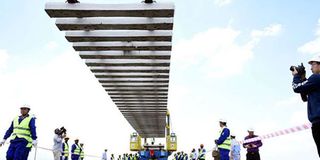China takes centrestage in Africa through infrastructure

Construction works on Phase 2A of the Kenya's standard gauge railway at Suswa. China Communications Construction Company are the contractors. PHOTO | GEORGE SAYAGIE | NMG
What you need to know:
- New report shows that East African governments fund only 12.9 percent of their projects in the region, with China funding 25.9 percent.
- President Xi Jinping has a grand plan to connect Asia, Africa and Europe through mega projects. The initiative involves infrastructure development and investments.
- Kenya has the largest number of projects in East Africa, with 41 projects valued at $38.2 million, followed by Ethiopia with 38 projects valued at $19.1 million.
Chinese contractors have taken centrestage in the implementation of infrastructure projects in Africa, as funding by the continent’s development finance institutions shrinks.
However, investment in social sectors such as health and education remained low, according to the report Africa Construction Trends (2018) by consultancy firm Deloitte.
The report, released last week, shows that East African governments fund only 12.9 per cent of their projects in the region, with China and international financiers funding 25.9 per cent and 20.1 per cent respectively.
“The significant role played by China in advancing funding for infrastructure development in East Africa speaks to the importance of the region as a touch-point for China’s Belt and Road Initiative,” the report says.
The initiative is Beijing’s multibillion-dollar Marshall Plan that seeks to strengthen Chinese global dominance through investment in infrastructure around the world worth more than $1 trillion.
President Xi Jinping has a grand plan to connect Asia, Africa and Europe through mega projects. The initiative involves infrastructure development and investments.
From Southeast Asia to Eastern Europe and Africa, the initiative connects 71 countries that account for half the world’s population and a quarter of global GDP.
So far Chinese companies have secured more than $340 billion in construction contracts along the Belt and Road.
The initiative was launched by President Xi Jinping in September and October 2013 during visits to Kazakhstan and Indonesia.
Sectors
According to the report, 33 per cent of the 482 projects tracked this year were built by Chinese companies and 24 per cent by local contractors.
However, large-scale investment in social development and education projects remained low, at 0.1 per cent each across the continent.
The majority of the infrastructure projects were in the transport sector (38.6 per cent), followed by real estate (22.8 per cent), energy and power (13.7 per cent) and shipping and ports (7.5 per cent).
According to the report, the transport sector, valued at $107 billion, represented 22.7 per cent of the continent’s total spend on large construction projects, with governments and China being the two significant funders of the sector.
The report notes that although African governments continue to fund the largest share of projects, particularly in the transport sector, the Chinese influence on the continent is increasing with 19 per cent of the projects being funded by China (close to one in every five projects) followed by international development finance institutions with (13.7 per cent), and private domestic firms with (10.6 per cent).
China is the most prolific (and single country) builder of projects, constructing 160 (33.2 per cent) projects this year, up from 85 last year.
The majority of Chinese construction also falls within the transport sector.
Other single-country builders include Italian firms, although they are some way behind with 21 projects (4.4 per cent), followed by French firms with 15 projects (3.1 per cent).
East Africa has the largest number of projects at 139 (29 per cent) and North Africa accounted for the largest share of projects in terms of value, at 31.5 per cent ($148.3 billion).




